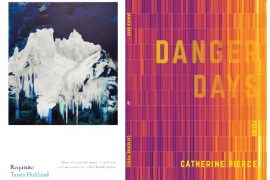In her debut collection The High Shelf, Nadia Colburn has gifted us with intimate and elegantly crafted poems. Colburn draws from her experiences of nature, pregnancy, and motherhood, and writes from her critical perspectives as an activist, Kundalini yoga instructor, and student of Thich Nhat Hanh. “What a tender book!” writes Pulitzer Winner Jericho Brown. “What an example of how to maintain tenderness while telling the truth.” Yes — while Colburn’s approach is cerebral and calculated, it never comes at the expense of feeling or revelation. “Spare, brilliant, and open-hearted,” writes Chase Twichell, poet and founder of Ausable press, “these poems do what we most need art to do in this perilous age: they show how the mind invents both itself and its world, and thus where our responsibility lies.”
Colburn earns the adjectives “spare” and “open-hearted” with demotic diction and thoughtful juxtaposition of text and white space. The poems speak with a rare kind of directness, and their arrangement on the page allows them to breathe and move at their own unrestricted pace:
Nearby long,
cold days; sky
like water; earth like trees.
Yellow berries the bear
walks by. Deer still
uninjured, still unafraid.
While individual poems constitute this collection, the book asks you to read it as a whole. The interstices of these poems seem just as important as the poems themselves. For full effect, read this book in no more than two sittings.
In “Plenitude/Pregnancy,” Colburn introduces the stylistic choices that will reverberate throughout the rest of the collection. The title primes us to think of these words together, and consider carefully their relationship. That slash does much work as well, allowing the words to sit side by side, each yielding to the other as they slide in and out of focus. Are these two the same? Do they oppose each other or do they work together? Is plenitude a restatement or interpretation of pregnancy?
In a section of the poem, Colburn address her unborn child:
in the fluid dark
what do you taste?
What do you
hear?
The internal the external,
that cannot be separated—
mother to mother to daughter,
passed on. Like a belief
no longer believed, but not yet entirely abandoned:
This passage exemplifies so much of Colburn’s style. She uses ordinary language, nothing that can be called too ornate. And yet, she breathes new life into classic rhetorical techniques. “Fluid dark” is a kenning for the womb. Her apostrophe to the unborn grounds the writing with a distinct voice: She brings subjectivity to her language through the interaction of one body with another, even as one body resides within the other. The passage ends with the second half of a simile, “like a belief…” which, in a move reminiscent of Emily Dickinson, lacks a clear tenor due to her fragmentary syntax.
This poem is immediately followed by two prose poems, presented in tight columns justified on both sides, unmissable as Colburn’s formal pendulum swings to the other side of fragmented verse laden with white space. In “Continuity,” Colburn writes:
The sky looks like something unspeakable about to be
said. Then doesn’t say it. In the world, look how many
things are in it. And we, like prairie dogs that make it
through the burning.
Colburn repeatedly evokes this feeling of anticipation — this feeling of being left hanging. In other poems, It reappears when she ends a line with a colon, then refuses to complete the thought with a resolution. In “The World’s Mirror,” she writes, “The mind imagines itself gone: / steps back, comes closer: // there:” Where A. R. Ammons might have used the colon to build momentum, Colburn uses them to show a holding of one’s breath. Here colons represent the intensity of attention given to a mystery about to crack, we hope, open.
So much of the power of these poems comes from the variable level of detachment with which Colburn writes. Consider the ending of “Reading the Newspaper by the Open Window:”
Who is the wonderful me of happiness?
Of forgetfulness,
of horror,
that must be a part?
As if “all”
were a word in another language.
Now no one speaks.
Colburn writes this poem as a moment of epiphany, of sudden awareness. The title of the poem situates us in a calm morning, in clear weather. The book falls away from the speaker’s consciousness with these perfect questions, the recognition that we do not live our lives in accordance with our being in the world. The poem unfolds into double meanings at the end, depending on how you interpret the final line. When she writes, “Now no one speaks,” is she describing her immediate, silent surroundings? Does she follow up the previous thought, alluding to a lost language in which it was possible to speak of the “all?”
And the question lingers, “who is the wonderful me of happiness?” It’s a beautiful, uplifting question that, when contemplated, reveals the alienation we feel towards our own joy. What does it say about you to see the you of happiness at a distance, to wonder who that happy person is? The boldly and appropriately titled poem “Happiness” may have an answer:
Inside my house there was my body, nestled by the bodies of the
ones I love.
How had I arrived? This measurable space, the stairs
so narrow that the bed frame needed to be sawed in half?
Here, happiness doesn’t appear in the solitary calmness of morning, but in the physical presence of family, the touching of loving bodies, the quarters of an unpretentious house. And happiness prompts another question, “How had I arrived?” Colburn doesn’t convey the emotion of happiness as much as consider it from a distance. The process of becoming a family becomes obscured by the reality of the present moment. It is as if happiness has happened to her, bringing her to a sublime moment it is appropriate only to describe.
A handful of poems seem, on first reading, out of place in this focused, contemplative book. “Given” is one that identifies, through a stichic catalogue of names, birds that have gone extinct, “King Island Emu / Mariana Mallard / Pink-headed Duck…” This poem of ecological awareness destabilizes what might be read as a wholly interior book, one that focuses on natural images to reveal inner experiences. However, as the poems collectively reveal, Colburn makes little distinction between the contemplation of her own experiences and the contemplation of her surroundings.
To show this lack of distinction, I want to focus on a conceit that Colburn uses to tie this book together: a box. In extraordinary turns of periphrasis, she often returns to the image of a box which she inhabits and contends with:
In the box, there was no beginning and no end, but an
openness stopped on all sides by the edges. We built it
with wood and painted it. And all along there was the
future. Which had no one direction.
The conceit of the box is difficult to understand at times. Should it be read metaphorically as a body? Is it a crib? Ultimately, the box reveals itself as a house, but defamiliarized to show the strange beauty of our daily existence:
Outside, all the other boxes. In some, no movement
at all. In some, dancing.
And it’s in the poem “The Feeling of Trying to Express the Feeling I Can’t Even Name” that Colburn explores this box most impactfully:
We assembled it. We made the corners tight, a box
that might hold all of us—
safe
from everything we wanted to escape and creating
the idea of escape itself.
Colburn recognizes how the given fixtures of our lives affect the nature of our thoughts. It is essentially impossible not to live within a house of some kind, and yet this act forces our minds into an act of dualism. We are at home, or we are not at home. We are safe or unsafe. These patterns of dualistic thinking are inventions, not reality – though Colburn does not go as far as to condemn them. The wonderful me of happiness must live somewhere.
Colburn, then, is indiscriminate in her contemplations—ecology, sociology, and biology all serve to be meaningfully observed. Her final gesture is to blend the text of the book with the paratext. Her “Afterward” and “Thank You” appear formally identical to the collection’s prose poems:
My hope is that these poems can help readers hold our fear and
our light; that they can help us live with emptiness and still find
safety, even without the supports of certainty and without closing
ourselves off; that they can open us beyond the dichotomy of self
and other, singleness and multiplicity; that they can help us wake
up with wonder and with engagement; that they can help us find
focus on what matters so that we can act accordingly.
Colburn gives us her intention and wish for how these will act in the world, how they can be useful to us in our lives. She uses the pronoun “us” to include herself in the community of her readers, and her gratitude towards those who helped her create the book feels part and parcel with the poems themselves. Importing the form of her poems into the paratext, Colburn calls into question where the poetry begins and ends. And I think the poems hold the answer.




